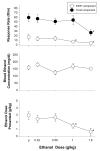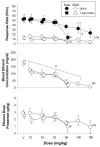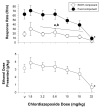A comparison of dehydroepiandrosterone and 7-keto dehydroepiandrosterone with other drugs that modulate ethanol intake in rats responding under a multiple schedule
- PMID: 22473025
- PMCID: PMC3360959
- DOI: 10.1097/FBP.0b013e32835342d2
A comparison of dehydroepiandrosterone and 7-keto dehydroepiandrosterone with other drugs that modulate ethanol intake in rats responding under a multiple schedule
Abstract
Dehydroepiandrosterone (DHEA), 7-keto DHEA, and several comparison drugs (ethanol, chlordiazepoxide, rauwolscine, and RO15-4513) were administered to male rats responding under a multiple schedule of food and ethanol presentation to determine their selectivity for decreasing ethanol-maintained responding. DHEA and 7-keto DHEA significantly decreased both ethanol-maintained and food-maintained responding, compared with the control, while also decreasing the blood ethanol concentration (BEC). Acute ethanol administration also decreased responding for both food and ethanol; however, ethanol-maintained responding was more potently decreased than food-maintained responding. BEC remained relatively stable after increasing ethanol doses. Among the other drugs tested, RO15-4513 was the most selective for decreasing ethanol-maintained responding compared with food-maintained responding, and it decreased BECs as ethanol-maintained responding decreased. The largest dose of rauwolscine significantly decreased responding for food, whereas it did not affect ethanol-maintained responding compared with the control. Low to intermediate doses of rauwolscine produced small, nonsignificant increases in ethanol-maintained responding and BECs. Chlordiazepoxide produced significant decreases in food-maintained responding and the dose of ethanol presented, but only at the highest dose tested. Although DHEA and 7-keto DHEA did not decrease ethanol-maintained responding as selectively as ethanol or RO15-4513 under the multiple schedule, these neurosteroids may be valuable pharmacological tools in the development of new treatments for alcohol abuse and dependence.
Figures





Similar articles
-
Comparison of dehydroepiandrosterone (DHEA) and pregnanolone with existing pharmacotherapies for alcohol abuse on ethanol- and food-maintained responding in male rats.Alcohol. 2015 Mar;49(2):127-38. doi: 10.1016/j.alcohol.2014.07.024. Epub 2015 Jan 6. Alcohol. 2015. PMID: 25620274 Free PMC article.
-
Effects of 7-keto dehydroepiandrosterone on voluntary ethanol intake in male rats.Alcohol. 2011 Jun;45(4):349-54. doi: 10.1016/j.alcohol.2010.08.020. Epub 2010 Nov 4. Alcohol. 2011. PMID: 21051179 Free PMC article.
-
Effects of noncontingent ethanol, DHEA, and pregnanolone administration on ethanol self-administration in outbred female rats.Alcohol. 2019 Mar;75:67-77. doi: 10.1016/j.alcohol.2018.05.003. Epub 2018 May 9. Alcohol. 2019. PMID: 30445249
-
Discriminative stimulus effects of ethanol, pregnanolone, and dehydroepiandrosterone (DHEA) in rats administered ethanol or saline as adolescents.Pharmacol Biochem Behav. 2009 Jul;93(1):82-90. doi: 10.1016/j.pbb.2009.04.012. Epub 2009 Apr 23. Pharmacol Biochem Behav. 2009. PMID: 19393687 Free PMC article.
-
Effects of positive and negative modulators of the γ-aminobutyric acid A receptor complex on responding under a differential-reinforcement-of-low-rate schedule of reinforcement in rats.Behav Pharmacol. 2010 Dec;21(8):727-35. doi: 10.1097/FBP.0b013e32833fa7c7. Behav Pharmacol. 2010. PMID: 20838210 Free PMC article.
Cited by
-
Comparison of dehydroepiandrosterone (DHEA) and pregnanolone with existing pharmacotherapies for alcohol abuse on ethanol- and food-maintained responding in male rats.Alcohol. 2015 Mar;49(2):127-38. doi: 10.1016/j.alcohol.2014.07.024. Epub 2015 Jan 6. Alcohol. 2015. PMID: 25620274 Free PMC article.
-
Drug effects on multiple and concurrent schedules of ethanol- and food-maintained behaviour: context-dependent selectivity.Br J Pharmacol. 2014 Jul;171(14):3499-510. doi: 10.1111/bph.12707. Br J Pharmacol. 2014. PMID: 24697498 Free PMC article.
References
-
- Arsenou ES, Fousteris MA, Koutsourea AI, Nikolaropoulos SS. 7-keto-delta(5)-steroids: key-molecules owning particular biological and chemical interest. Mini Rev Med Chem. 2003;3:557–567. - PubMed
-
- Balakleevsky A, Colombo G, Fadda F, Gessa GL. Ro 19-4603, a benzodiazepine receptor inverse agonist, attenuates voluntary ethanol consumption in rats selectively bred for high ethanol preference. Alcohol Alcohol. 1990;25:449–452. - PubMed
-
- Barrett JE, Weinberg ES. Effects of chlordiazepoxide on schedule-induced water and alcohol consumption in the squirrel monkey. Psychopharmacologia. 1975;40:319–328. - PubMed
-
- Belelli D, Lambert JJ. Neurosteroids: endogenous regulators of the GABA(A) receptor. Nat Rev Neurosci. 2005;6:565–575. - PubMed
-
- Belzung C, Misslin R, Vogel E, Dodd RH, Chapouthier G. Anxiogenic effects of methyl-beta-carboline-3-carboxylate in a light/dark choice situation. Pharmacol Biochem Behav. 1987;28:29–33. - PubMed
Publication types
MeSH terms
Substances
Grants and funding
LinkOut - more resources
Full Text Sources
Medical

